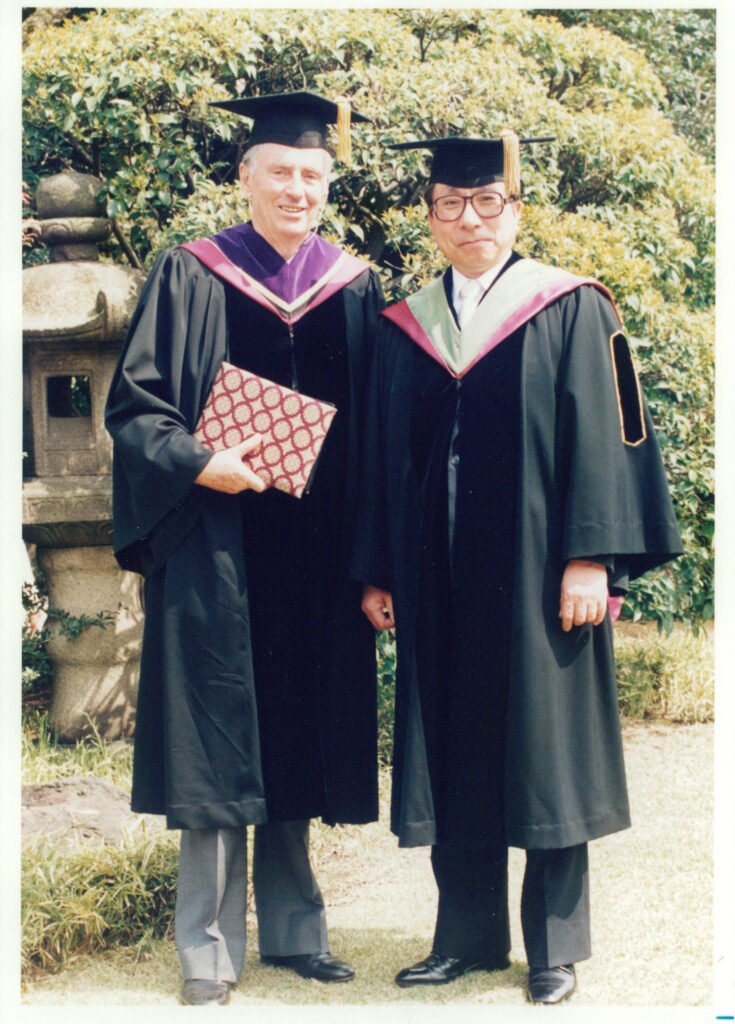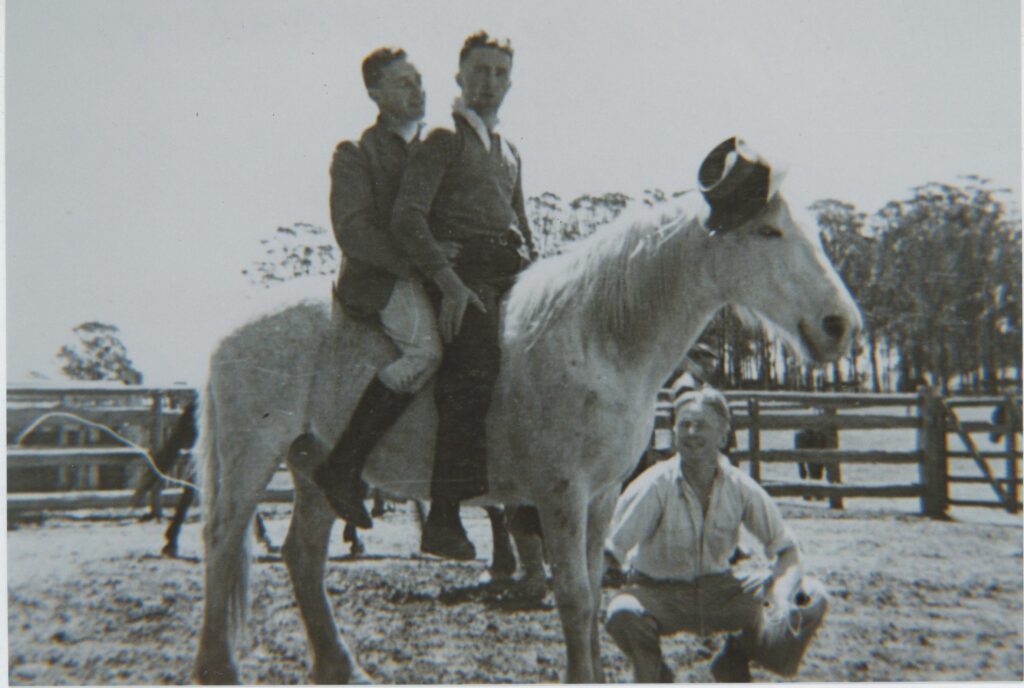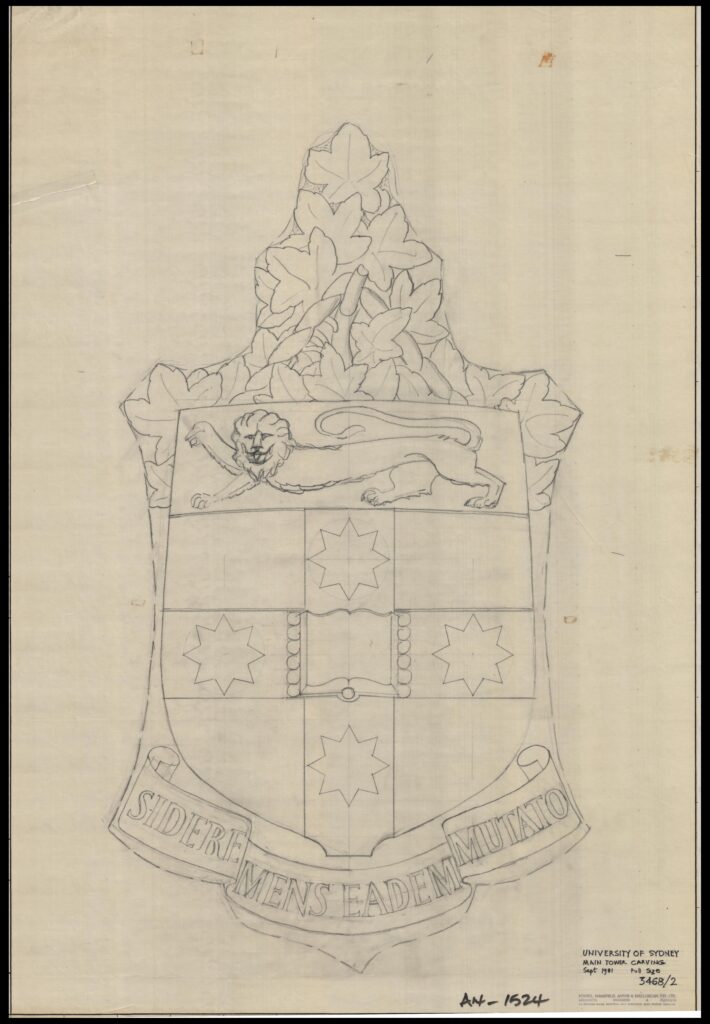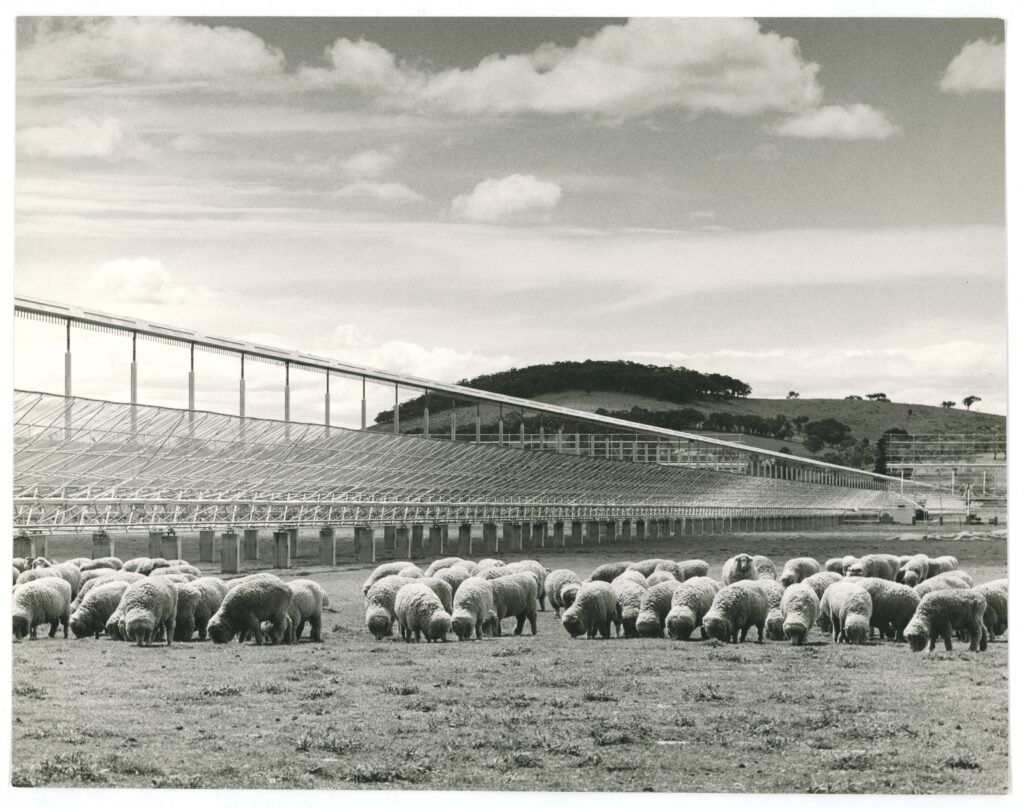The University Archives turns 70 on 3 May this year. To celebrate this milestone, check the blog at the end of each week for the week’s special stories from our collections.

22 April 2024
The University’s Saddest Day
On 4 May 1981, Senate recorded the, “Retirement of Professor Sir Bruce Williams as Vice-Chancellor and Principal” and noted that, “The Chancellor suggested that two functions be held to farewell Professor Sir Bruce Williams as Vice-Chancellor, one function for Fellows of Senate and members of the academic and administrative staff in the Great Hall late one afternoon, and a second to enable the Vice-Chancellor to take leave of public bodies and persons outside the University with whom he has been involved in the course of his work”. At the next Senate meeting, on 1 June 1981, it was decided that, “On the motion of the Chancellor, seconded by Mr Justice Selby, the Senate appointed Professor J M Ward, Deputy Vice-Chancellor, as Acting Vice-Chancellor from 1 July 1981 until such time as the new Vice-Chancellor and Principal takes up duties”. On 7 September 1981, Senate heard that the “Committee appointed to recommend an appointment to the position of Vice-Chancellor and Principal” advertised, “…the position both in Australia and overseas…in the press in Australia, New Zealand, United Kingdom, USA, Canada, Malaysia, Singapore, Hong Kong, India, Pakistan, Sri Lanka, Kenya and Nigeria…sent letters to the Chancellors of Universities in Australia, New Zealand, United Kingdom and Canada, inviting suggestions as to persons who might be considered…In the event, the position was in this instance more widely advertised than ever was the case before”. Despite this extensive search to fill the position of Vice-Chancellor and Principal, the Committee unanimously recommended the appointment of Professor John Manning Ward but, “The hope was expressed that the period of appointment would be longer than the three years and four months remaining to the end of the year in which Professor Ward would turn 65”. There was no cause for concern, however, as Professor Ward went on to hold the position until 1990.
On 4 December 1989, Chancellor Sir Hermann Black proposed, “…that at this particular meeting it [Senate] records its gratitude and thanks to the Vice-Chancellor and Principal for his services in office”. (Sir Black also noted that, “Alas, I shall miss out on the post-Senate dinner. But I trust it is very enjoyable. I shall be present as a disembodied spirit, smacking my lips and committing the Christian sin of envy as you enjoy it.”). Senate, as per the Chancellor’s recommendation, placed, “…on record at this last regular meeting of Senate under the University and University Colleges Act 1900, its sincere gratitude and thanks to Professor J M Ward for his outstanding services to the University as a Professor for forty years, as a Chairman of both the Professorial and Academic Boards, and since 1981 as Vice-Chancellor and Principal of the University during a time of considerable change and difficulty. The motion was carried unanimously with acclamation”. During the same meeting, Senate resolved to confer the title of Emeritus Professor upon Professor Ward from 1 February 1990 when he retired.
This image captures Emeritus Professor Ward being awarded an honorary doctorate by Waseda University on 2 April 1990, around a year after Dr Haruo Nishihara of Waseda University was extended the same honour at the University of Sydney. This relationship between the universities was established in 1985, during Emeritus Professor Ward’s tenure as Vice-Chancellor and Principal, when a Cultural Agreement was signed to encourage academic and student visits and the sharing of research and resources. Emeritus Professor Ward received this honorary doctorate just a month before his death on 6 May 1990. The 8 May 1990 University of Sydney News Special Edition reported that, “The University community was deeply shocked to learn in the hours following the tragic train crash near Hawkesbury River Station on 6 May that former Vice-Chancellor, Emeritus Professor John Ward, 70, his wife Patricia, 69, his daughter Jennifer, 36, and Moira Jennings, the wife of the Registrar, were among those killed”. The article remembered the incident as the “University’s saddest day”.
Honorary Degree Conferred Upon John Manning Ward by Waseda University, Japan (1990), [REF-00076861]. University of Sydney Archives, accessed 22/04/2024, https://archives-search.sydney.edu.au/nodes/view/127047.
23 April 2024
A Series of Faux Pas
On 16 July 1936, the Vice-Chancellor wrote to the Chairman of the McGarvie Smith Institute, “I have been asked by the Senate of the University to convey to you, and the other Trustees of the McGarvie Smith Institute, its cordial thanks for the munificent gift which you have made to the University for the purposes of an experimental farm in connection with the Veterinary School. Your donation of £5,000 for immediate improvements, and your contribution of £500 a year for ten years for maintenance, have enabled the University to see the way open for the purchase of the property, and steps are now being taken to that end. I need scarcely assure you that the University will do everything in its power to make the new project a success, firmly believing that it will be of inestimable value to the primary industries of Australia”. The property in question was a 400-acre site near St Mary’s in the Penrith area, the purchase of which for £3,700 using “accumulations from the McCaughey Fund” was approved by Senate a week earlier, on 6 July 1936, for the,”…purpose of providing a practical training school of Veterinary Science students”.
Exactly one year later, the Vice-Chancellor, on 16 July 1937, was compelled to write to the McGarvie Smith Institute, reporting that although, “It is pleasing to be able to report the uniformly favourable opinions of veterinarians, agrostologists, pastoralists and others who have visited the farm”, “When asked by your Directors what sum would be required to equip the McGarvie Smith Farm as an efficient teaching and research unit, an estimate was prepared in consultation with men experienced in farm and station equipment, which indicated that with due economy this could be done for a sum of about £5,000. In arriving at this estimate the guiding ideas were that the farm should provide for students examples of the best modern farming practice under Australian conditions, and, at the same time, include the necessary facilities for general experimental work on stock problems…In addition, simple accommodation, rather on army lines, should be provided for students and staff in residence…When it was decided to purchase the necessary land, after your Directors had made a grant for equipment and maintenance, the preparation of detailed estimates was undertaken. It soon became evident that the original estimate of £5,000 for equipment would not be sufficient to provide all the facilities hoped for. Accordingly, it was reluctantly decided to omit various items with the hope that the opportunity of including these would come at some future date”. The Vice-Chancellor requested an additional £2,500 to, “…enable the farm to be fully equipped from the start, and thus attain its maximum usefulness at the earliest possible date”. The McGarvie Smith Institute responded on 9 August 1937 that, “It is regrettable that your estimates were so far out in the first place, but after what you were able to show us when visiting the farm last week, and upon hearing your verbal explanation, my Board is disposed to grant you the further £2,500 asked for”. The Vice-Chancellor hoped, on 12 August 1937, that, “…the results of our work will show that your generosity has not been misplaced”.
The McGarvie Smith Institute was again contacted in 1941 with a request for additional funds. The Vice-Chancellor wrote on 24 March 1941, “Through the generosity of the McGarvie Smith Trust in making provision for teaching and research in Animal Husbandry at the McGarvie Smith Animal Husbandry Farm, it has been found possible greatly to extend the course in Animal Husbandry in the Faculty of Veterinary Science…if the farm is to serve effectively as the principal centre for the training of students in Animal Husbandry, considerable extensions of the buildings and accommodation and additions to the stock maintained, are urgently necessary….It may be pointed out that the McGarvie Smith Animal Husbandry Farm is the only Institution of this type in Australia, and since students in the Faculty…come from all States of the Commonwealth (with the exception of Queensland), and New Zealand, it should, if adequately equipped play an important part in relation to the livestock industry, not only of this State but of the whole Commonwealth…the name of McGarvie Smith is destined to be associated with veterinary education and research throughout the Commonwealth…It is suggested that the McGarvie Smith Trust might be prepared to consider associating their work not only with the McGarvie Smith Farm but with the parent Veterinary School at the University itself”. Senate heard on 5 May 1941 that £9,000 would be donated to the University.
This came at the same time as Lecturer in Zootechny, Frank Whitehouse’s vociferous paper titled, “The Farm and Animal Husbandry”, where he argued that, “The Farm was bought when the Faculty was at fever heat with excitement at purchasing a farm – and the warning that the Farm was too far from the railway station (14 1/2 miles from Cabramatta) went unheeded. This distance is the reason for the failure of the Farm…The stables are the dustiest and dirtiest I have encountered in any Government institution in New South Wales. The dairy bails and building induce scorn from people experienced enough to express an unbiased judgment…The milk house is diametrically opposed to fundamental principles laid down by the Dairy Branch and the Milk Board. The piggery has been absurdly placed on the side of a hill, each sty-yard draining into the next beneath, and all styes draining into the boar paddock, which is opposed to sound teaching in veterinary hygiene and bacteriology…The stables are an abortion. The dairy is an abortion. The milk house is an abortion. The piggery is an abortion. AND the causal agent was definitely not lack of finance [‘lack of finance’ underlined]…the farm buildings are a disgrace – to any farmer [‘disgrace – to any farmer’ underlined] – and particularly to the University…The Farm venture has been a series of faux pas from its inception and it is my opinion that the further expenditure of money on it would be sinking money into a bottomless well”. It is unclear how much attention this paper generated within the University, however, a year later, the McGarvie Smith Institute went on to donate a further £13,500 to the University.
Wally Mills on a Horse with Bill Stephens Kneeling Beside Horse at the Badgerys Creek University Farm (? 1941), [REF-00087862]. University of Sydney Archives, accessed 23/04/2024, https://archives-search.sydney.edu.au/nodes/view/140541.


24 April 2024
No Hurdy-Gurdy Chimes
The “Report of the Senate of the University of Sydney for the year ended 31st December 1924”, presented at the 1 June 1925 Senate meeting, noted, “After receiving a recommendation in favour of a War Memorial Carillon from the Advisory Committee on University Life in November, 1923, the Senate consulted its own War Memorial Committee, and in December directed the formation of a General Committee for a University War Memorial to be raised by private subscription of members and friends of the University to take the form of a Carillon…collection of the necessary fund began on 14th May with the issue of a circular, dated 6th May, asking subscriptions for a carillon of forty-nine bells, at a total estimated cost of £15,000, including the expense of installation in the clock tower of the University”.
On 3 June 1927, Senate heard from the Carillon Executive Committee that, “…it was decided that the plans should provide for four dials for the clock and that they should be illuminated. It was further decided that the best bell in the Carillon should be used as the strike bell of the clock, and that arrangements should be made for automatic playing of the Carillon at certain clock hours. Upon this resolution the following telegram…was sent…”Desire instal clock faces on four sides Tower work electrically master clock connected Carillon for strike and short melody before striking – stop – advise cost and time required provide clock installation – stop – currents available one hundred twenty volts direct two forty single phase four fifteen three phase cable reply”. On 16 November 1927, a reply was received, “Electric clock operating four dials with mechanisms striking hours also Westminster quarters on four bells about five hundred sixty pounds ready in time of ordered now send size clock face testing carillon December twelfth shipment early January”.
The University, however, was unhappy with the specifications for the clock, writing on 23 November 1927 that, “I forgot in my other letter to draw your attention to the fact that we did not ask for Westminster quarters. If the University clock struck the quarters, it would be a nuisance to both lecturers and students during terms. Beyond that, most of us felt, I think, that there are quite enough Westminster quarters to be heard in Sydney at the present time. They are in fact trite and hackneyed to a wearisome degree. Mr. Justice Ferguson suggested that the University should obtain some verse or verses and appropriate music…rendered by the bells once every day…I am sorry for this misunderstanding as I fear that it may affect the price. It certainly gets away from the mechanical hurdy-gurdy arrangement of Westminster chimes. Last year I told Taylor that we wished to be able to have melody at clock hours and even to connect the automatic machine to the clock so that we might have music any time we liked at clock hours, e.g. on Sundays and holidays. He promised to go into the matter…Since then I have heard nothing. It presumably went on the shelf with the rest of our work”. This was followed by a telegram on 24 November 1927, “Firm of Watson Sydney representing Gent of Leicester desires to tender for clock please communicate with Gent – stop – Westminster quarters utterly unsuitable – stop – require brief melody before strike only – stop – Handel’s Toll for the Brave is suggested if suitable – stop – arrange to disconnect melody as may be required – stop – desirable also to connect automatic player to clock for varied melodies at clock hours on certain days – stop – cable result further enquiries – stop – present clock dial face four feet five and three quarter inches square – stop – sketch posted – stop – plans bells installation in tower arrive Taylor’s within two weeks”.
Main Building – Full Size Drawing of Main Tower Clock Tower Carving – Coat of Arms (Sep 1981), [REF-00083871]. University of Sydney Archives, accessed 24/04/2024, https://archives-search.sydney.edu.au/nodes/view/135611.
26 April 2024
Observations of the Heavens
A statement released by the Chatterton Astronomy Department within the School of Physics and the School of Electrical Engineering announcing “The new Radio Astronomy Centre of the University of Sydney” noted that, “Radio astronomy is concerned with observations of the heavens at radio wavelengths rather than with light waves. It is a relatively new and vigorously growing branch of one of the oldest of the sciences, and Australia has taken a leading part in its development. Almost all of the Australian work, so far, has been carried out by the radio astronomy group in the Radiophysics Division of C.S.I.R.O. Recently, however, several members of this group have joined the staff of the University…One group, led by Dr. B. Y. Mills [Bernard Yarnton Mills], who was previously with C.S.I.R.O., will engage immediately in radio astronomy work…Radio astronomy, however, is the meeting point of astronomy, physics and all the most advanced techniques of electronics and electrical engineering…The Centre will mean the pooling of resources, intellectual and material of the Schools of Physics and Electrical Engineering for an attack on some of the major fundamental problems of radio astronomy…One of the first problems to be considered by the Radio Astronomy Centre is that on which Dr. Mills has been engaged for some years; the detailed observations of sources of radio emission both in our own galaxy and in the very distant regions of space…perhaps help to answer the age-old question as to its origin. For the new studies a very large radio telescope will be needed, far too large to be built in a completely steerable form, such as the large paraboloid being constructed by the C.S.I.R.O. at Parkes. The radio telescope needed for this work must have dimensions of about one mile and the most suitable form for this is a cross-like structure invented by Dr. Mills and called a Mills Cross. The cost of a radio telescope of this type and size will be about £300,000. The Chatterton Astronomy Department supported by the Nuclear Research Foundation has set aside £100,000 for the first stage of this telescope. The rest of the cost to complete the instrument to its full size must be raised elsewhere”.
Dr Mills reached out to possible donors both within and outside of Australia. In one letter to Dr GF Mulders of the National Science Foundation (NSF) in Washington DC, dated 2 February 1961, Dr Mills wrote, “The instrument will be almost [underlined] unique! It is known that a similar Cross has now been completed in the U.S.S.R., but our information is that the resolution and general flexibility is considerably less. Another instrument…is under consideration in Holland. As far as I know ours is the only instrument of this type in which spectral information will be obtained by simultaneous observation on two frequencies…Finally, and most important, is the location in the southern hemisphere…In order to study the central and southern regions of the Galaxy and the Magellanic Clouds…it is essential to have such an instrument in the southern hemisphere”. By this point, however, it appears the estimated cost of the Mills Cross Telescope had more than doubled since the Radio Astronomy Centre statement, “The estimated cost of our radio telescope is about £660,000, of which £220,000 is currently available. This is for the minimum amount of complexity…There appears little prospect of raising the additional sum from governmental contribution in Australia and it seems we must obtain support overseas if the instrument is to have a size and flexibility commensurate with the observational problems to be tackled”.
On 7 December 1961, Dr Mills wrote to the Australian National University with an update, which indicated that a funding proposal was formally submitted to the National Science Foundation and that the, “…grant was in fact approved by the National Science Board last October and I have been led to believe that the delay in finalizing the grant and the reason for Dr. Keller’s [Program Director for Astronomy at the NSF] present visit may be connected with some objections from C.S.I.R.O., principally on the basis that the magnitude of the project has been underestimated and our facilities are inadequate. I expect that we will be able to demonstrate to Dr. Keller that this is not the case, particularly in view of the very stimulating support of our development work by local industry in making available their experience and manufacturing facilities at nominal, and sometimes zero, cost”. The Vice-Chancellor in another letter to the Australian National University, dated 8 December 1961, noted that the grant amount was $746,000 [US dollars]. The grant was eventually finalised in 1962 albeit with delays, which prompted Professor Harry Messel to send a telegram on 16 February 1962, “Mills project and group now seriously held up stop please notify when we can expect approval your end”.
Although the promised National Science Foundation funds were received, the project continued to be plagued with financial problems, even as Dr Mills could report to the NSF, on 4 May 1965, “You will probably be pleased to hear that we are at last fully operational with the E-W arm of our Cross…At present several people are busy analyzing results with a view to some early publications, which, I think, would be a good thing politically. We are running into some troubles because of the failure of your financial people to forward cash advances as requested. I wonder if you might investigate and try and lubricate the wheels a little”. The Mills Cross Telescope housed at the Molonglo Radio Observatory was opened in November 1965, however, the project still faced an “uncertain future” as on 20 October 1967, the NSF informed Dr Mills that, “Although until very recently I had hoped we could continue for one more year the support of your operation, this now appears to be very doubtful. Therefore, I am urging you to start looking for local sources of money to continue your work with the Mills Cross. I regret to have to tell you this, with so little notice, but at least I had given you some advance warning that the ax (is this correct? Or axe?) might fall one of these days”. Dr Mills responded on 30 October 1967 declaring the news as, “…rather a shattering blow to our project”. Dr Mills provided “some calculations” and noted that, “It is perhaps rather ludicrous that the future of such an expensive project should be threatened by the lack of such a small sum…I hope that you will not find it necessary to drop us entirely”. It seems the NSF did not after all “drop us entirely” and enabled the University to successfully continue operating the Telescope and Observatory, as Dr Mills wrote to the NSF on 11 August 1980, “Nearly twenty years ago the National Science Foundation funded the construction of our Molonglo Radio Telescope and, although we are now supported entirely by local sources, it is evident that the project could not have begun without the NSF grants…Observations have ceased at 408 MHz and the radio telescope is currently being upgraded for use at a higher frequency and in a synthesis mode”. Enter the Molonglo Observatory Synthesis Telescope (MOST).
Mills Cross Radio Telescope Construction (Circa 1962 to 1967), [REF-00089308]. University of Sydney Archives, accessed 26/04/2024, https://archives-search.sydney.edu.au/nodes/view/142158.

Explore the blog for other posts from the University of Sydney Archives and follow us on Instagram.